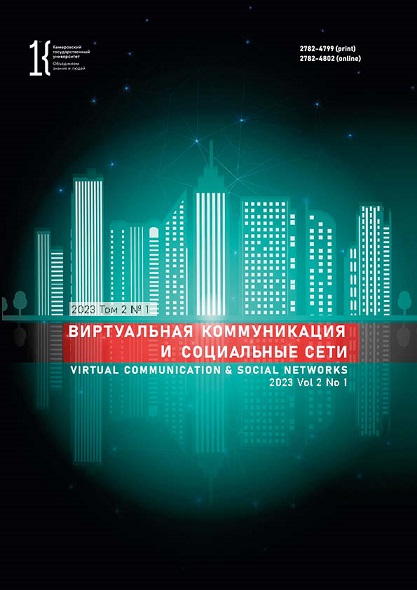Tver, Russian Federation
Television is a global phenomenon with national peculiarities. This article introduces a chronological and comparative analysis of the development of television in West and East Germany. A systematic view of this phenomenon involves both technical and social aspects. From a technical innovation available to the privileged, it turned into a mass medium that performs an integrative function by shaping and broadcasting the current discourse. The research objective was to find out the specifics of television in Germany and correlate the global trends with the national context. The XX century erased the borders between such incompatible phenomena as dictatorship and democracy, and all these phenomena affected the content of TV shows, people’s attitude to television, its new genres, social functions, etc. The author revealed five stages in the development of German television. Stage I (late XIX century – 1945) was the age of technical discoveries, attempts at their practical implementation, and the early regular broadcasting during the period of National Socialism. Stage II (late 1940s – 1950s) marked the restoration of television broadcasting and the parallel development of television in the Federal Republic of Germany and the German Democratic Republic. Stage III (1960s –1970s) clarified the institutional framework and social functions of television. Stage IV (1980s – mid-1990s) saw the emergence of new broadcasting technologies and commercial TV channels, as well as the collapse of the Eastern bloc and the reunification of Germany. Stage V (since 1990s) is connected with digitalization.
Germany, television, mass media, FRG, GDR, discourse
1. Adorno T., Horkheimer M. Dialektic of Enlightenment. Philosophical Fragments. Moscow: Medium; St. Petersburg: Yuventa, 1997, 312. (In Russ.)
2. Kolomiets V. P. Mediatization of media. Moscow: Izd-vo Moskovskogo un-ta, 2020, 256. (In Russ.) https://elibrary.ru/oodsdw
3. Luhmann N. The reality of the mass media. Moscow: Praksis, 2005, 256. (In Russ.) EDN: https://elibrary.ru/PWYQPR
4. Heidegger M. The origin of the work of art. Moscow: Akad. proekt, 2008, 528. (In Russ.) EDN: https://elibrary.ru/QWTDYP
5. Aurich R. Eberhard Fechner: Chronist des Alltäglichen. München: Edition Text + Kritik, 2019, 208.
6. Busse D. Historische Semantik. Analyse eines Programms. Stuttgart: Klett-Cotta, 1987, 334.
7. Eckert G. Die Kunst des Fernsehens. Emsdetten Westf.: Lechte, 1953, 105.
8. Engell L. Das Schaltbild: Philosophie des Fernsehens. Göttingen; Konstanz: Konstanz University Press, 2021, 432.
9. Fahlenbrach K. Medien, Geschichte und Wahrnehmung: eine Einführung in die Mediengeschichte. Wiesbaden: Springer VS, 2019, 305.
10. Fehr A. Fernsehen – Internet – Konvergenz: Klassifikationsmodell und Typologie konvergenter Bewegtbildangebote. Wiesbaden; Heidelberg: Springer VS, 2020, 258.
11. Frohne U., Haberer L., Urban A. Displays und Dispositive. Ästhetische Ordnungen. In: Display – Dispositiv: ästhetische Ordnungen, hrsg. von U. Frohne, L. Haberer und A. Urban. Paderborn: Wilhelm Fink, 2019, 9–60.
12. Heyen S. Die AfD in den Medien: Eine Framing-Analyse der Partei am Beispiel politischer Talkshows. Berlin: Carl Grossmann Verlag, 2020, 190.
13. Hickethier K. Geschichte des deutschen Fernsehens. Stuttgart; Weimar: Metzler, 1998, 594.
14. Hoff P. "Vertrauensmann des Volkes". Das Berufsbild des "sozialistischen Journalisten" und die "Kaderanforderungen" des Fernsehens der DDR – Anmerkungen zum politischen und professionellen Selbstverständnis von "Medienarbeitern" während der Honecker-Zeit. Rundfunk und Fernsehen, 1990, 38(3): 385–399.
15. Jarren O. Getrennte Wahrnehmungswelten. Die Medienstrukturen in Deutschland West und Ost sind noch kein gesamtdeutsches Forum. Der Tagesspiegel, 1997, (2).
16. Koselleck R. Begriffsgeschichten: Studien zur Semantik und Pragmatik der politischen und sozialen Sprache. Frankfurt am Main: Suhrkamp, 2006, 569.
17. Newiak D. Einsamkeit in Serie: Televisuelle Ausdrucksformen moderner Vereinsamung. Wiesbaden: Springer VS, 2022, 335.
18. Picht G. Die deutsche Bildungskatastrophe: Analyse und Dokumentation. Olten; Freiburg im Breisgau: Walter-Verlag, 1964, 247.
19. Stadelmaier G. Deutschlandglotzen: ganze Tage vor dem Fernseher. Springe: zu Klampen, 2020, 198.
20. Walser M. Stichworte zu einem Plädoyer. Magnum, 1959, (23): 60.















